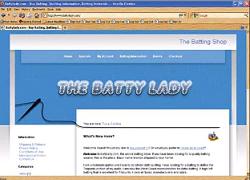By Patrice Lewis
Of all the decisions start-up business owners have to make, the decision of how to finance one’s business has to be the thorniest. Do you beg, borrow or steal the money? Who can afford to finance a business these days?
There’s no easy solution, especially in this economy. But the fact is, hundreds of thousands of people have started craft businesses and galleries, sometimes on the flimsiest of budgets. With care and planning, you can too.
Don’t quit your day job
This may seem self-evident, but those nasty, time-consuming, traffic-clogged, mind-numbing, I-hate-my-boss jobs have one big advantage your business doesn’t—a steady income. And, assumedly, the occasional day off.
This mixture can be magic. Your day job provides the income to pay your regular bills. Your evenings and weekends provide the time to start turning your craft hobby into a craft business. So whatever you do, don’t quit your day job on the touching hope that your craft business will be an instant financial success. Because, in all likelihood, it won’t.
Obviously, if you’re already unemployed, now might be the time for a what-the-heck, let’s-give-it-a-try business launch. But I wouldn’t give up looking for steady outside work (at least part-time) in the meanwhile. In this economy, cling to whatever income you have or can get.
You’ve got what it takes
Now for the sterling silver advantage craftspeople have over other start-up businesses: Most people don’t just pluck a home craft business idea out of thin air. They start the business by expanding an existing hobby, talent, skill or trade. That means often they already have the basic tools or materials or knowledge necessary.
This is wonderful news because, although you may need to upgrade to more professional-quality tools later on, at least you have what you need to get started. Lots of small craftspeople (ourselves included) started their businesses using hobby-quality tools and machinery. So can you.
A different way of thinking about this is to make a craft product that is compatible with tools you already own. Tools such as a sewing machine or a band saw are versatile and easily adapted to any number of crafts. And, presumably, you own those tools because you’re already something of an expert in using them. Perhaps you’ve only been making Christmas presents for the grandkids up to this point, but nothing says you can’t use those same tools (and that same knowledge) to expand your repertoire into more sophisticated crafts that are marketable and have a wider appeal.

Penny wise, pound foolish
Sometimes a smart businessperson knows what not to spend money on. Kathy Pine of WorldWise Jewelry spent precious time and money trying to acquire skills she didn’t need to build her business—namely, learning how to build a website and how to properly photograph her pieces.“I assumed that it would be faster and more cost-effective to do things on my own, ”she notes.“I spent literally months designing my own website (when I had no website development experience to speak of), months trying to learn how to take high-quality photos of my jewelry (when I barely knew how to use my camera), and more months trying to learn how to use Photoshop (making myself crazy just trying to figure out how to resize a photo for the Web).”The results, she says, were mediocre at best.
She learned a valuable lesson: Not everything associated with running a business must be done personally by the business owner. “By using experts to help me with things I don’t know and don’t really have a desire to learn,” concludes Pine, “I’ve been able to spend much more of my time doing things that are within my area of expertise— making jewelry (and therefore making money!).”
Black-and-white
Nonetheless, starting a business will take money, and that’s a commodity that might be in short supply in your household. So it’s time to get real. Putting everything down on paper is a superb method for figuring out expenses. There’s nothing like seeing those stark black-and-white numbers that don’t lie.
“Really look at everything you expect to buy when it comes to running your business—website expenses, supplies (office, raw materials, equipment, etc.), insurance, canopies/booths, display furniture, advertising (business cards, banners, postcards), and gas and travel expenses,” advises Michelle Sholund of By the Bay Botanicals. “It should be outlined on paper to see it all in black-and-white to determine if you can afford to start your own business with what money you have—and more importantly, keep running it when times are tough. People must be honest with themselves financially, and not look at the new business with rose colored glasses. This way, the opportunity for success becomes greater. I know firsthand how miserable it is [to use] all your hard earned money to pay expenses that could have been avoided—like credit card debt, which is the first killer of start-up art or craft businesses. There is nothing wrong with taking some time to save extra money because you will, in the long run, save more money by not paying finance charges and other fees that comes with credit cards or loans.”
Debt is dumb
In the words of financial advisor Dave Ramsey, debt is dumb. In fact, it’s about the dumbest way you can finance your craft business. The harsh reality is, if your business fails, you’re still stuck with the debt.

Far better to adopt artist and teacher Susie Monday’s philosophy of pay as you go. Sure, it’s not as quick, but it’s a far safer method. “The only feasible way for me to finance my work has been with a pay as- I-go approach, ”says Monday.“ I cash-flow my business with a really simple budget every two weeks—that’s a short turnaround, I know, but for now, that’s about as far out as I can go financially.”
Monday worked as a nanny for five years to some children who had lost their mother to cancer. This allowed her to work on her art while the children were in school.“After about five years, the kids were on their own driving,” she says. “I was out of nannyville, but I had the time, experience and had built a résumé as an artist during my off-hours. By that time, I was both selling enough and had teaching opportunities to finance my time in the studio. I occasionally have to rely on credit cards for travel, especially when I teach at a venue far from my home. Cash flow can be tricky. But I aim to pay off those cards as soon as the expense checks come in, and I have managed not to get too far into debt at any time.”
Credit card caveats
So is there ever a situation where the judicious use of debt can allow the small businessperson to get a business off the ground? Yes…but with caveats. Remember, if your business fails, you’re still saddled with whatever debt you incur. Therefore, you must approach your business like a business (a surprising number of people still treat a business like a hobby and make poor business decisions). It requires discipline and hard work.

Alicia Campbell, affectionately called “The Batty Lady” is an example of how the careful use of credit cards enabled her to finance her start-up business. “Starting a business at the beginning of a slowing economy is probably not one of the smartest things to do,” she admits. “I started The Batty Lady (a quilt batting supply source) in February 2008. I was on my own for financing, through the use of my personal credit cards. I probably wouldn’t recommend it, unless you have the financial capability to pay back the cards out of other income if the business fails. I have a day job in addition to my little business. Since the business is home-based, I don’t have the rental expense of a brick-and mortar store, but there are regular monthly expenses that have to be met (credit cards, website, advertising). My initial expenses were inventory, about $8,000 worth of stock needed to be purchased to cover the website and the quilt shows that I would be attending within the first few months of business.”
Campbell concludes, “I am now working on paying off all the start-up costs so that I can be a pay-as-you-go business and eliminate any interest expenses.”Campbell’s case illustrates that, even when a business succeeds, debt still needs to be paid off.
A means toward an end
Finding the money for a start-up small business is not easy. It’s not supposed to be easy. If it were easy, everyone would be doing it. Like anything worth doing, financing a business usually requires a complete philosophical change from immediate gratification to deferred rewards.
How can you finance a business without going into debt? You use the principles of deferred rewards. Skip the restaurant dinner and apply those funds toward your business instead. If you have a favorite vice (smoking, shopping, etc.), you could give it up and apply those funds to the business.
But even if you’re as thrifty as can be and apply all your spare money toward funding the business, life can get in the way. A new baby or aging parents may mean you’ll have to defer your business dreams for a while. Be patient.
And nothing says you can’t run your business under less-than-ideal circumstances—a cramped garage instead of a shiny new shop building; a secondhand sewing machine on the kitchen table instead of the latest model in a dedicated sewing room. Dreams that are nurtured and built slowly over time often yield the strongest successes (think oak trees).
Some of the most successful craft entrepreneurs we know are a couple who started an oil-and-incense business on a card table in their spare bedroom. Fifteen years later, they employ five people, rent a large warehouse and supply stores all over the country.
Dream big, start small. Don’t do the opposite. Remember: Bill Gates started in his garage. You can too.
Patrice Lewis is a wife, mother, homesteader, homeschooler, author, blogger, columnist, and speaker. An advocate of simple living and self-sufficiency, she has practiced and written about self-reliance and preparedness for almost 30 years. She is experienced in homestead animal husbandry and small-scale dairy production, food preservation and canning, country relocation, home-based businesses, homeschooling, personal money management, and food self-sufficiency. She and her husband have been married since 1990 and have two daughters.






